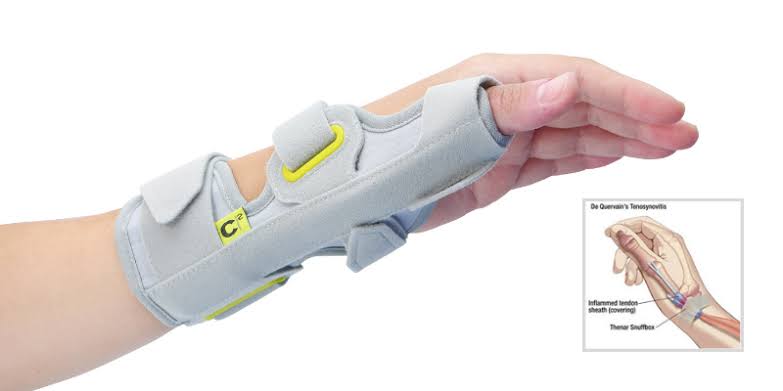De Quervain’s tenosynovitis, also known as De Quervain’s syndrome, is a common condition that affects the tendons in the wrist and thumb. It leads to pain, swelling, and discomfort in the affected area, making everyday tasks challenging for those affected. In this blog Understanding De Quervain’s Tenosynovitis: Causes and Treatment. We will delve into who commonly gets De Quervain’s, how it develops, and the available treatment options.
Commonly Affected Individuals
De Quervain’s tenosynovitis is more prevalent in certain groups of individuals. It commonly affects women, especially those who are in their 30s or 40s. Pregnant women or new mothers may also experience this condition. This is due to hormonal changes and repetitive movements involved in caring for a newborn. Additionally, people who engage in activities that put repeated stress on the wrist and thumb are at a higher risk of developing De Quervain’s. These include gamers, musicians, or those involved in manual labor.
Signs and symptoms
De Quervain’s tenosynovitis typically presents with the following signs and symptoms:
- Pain: The most common and prominent symptom of De Quervain’s is pain. The pain is usually felt along the back of the thumb and the side of the wrist. It may gradually develop or appear suddenly. It tends to worsen with thumb and wrist movements, especially when grasping or twisting objects.
- Swelling: The affected area may become swollen and tender. Swelling can be observed over the base of the thumb and may extend a short way along the back of the thumb or the wrist.
- Difficulty with Thumb Movements: People with De Quervain’s may experience difficulty and pain when making a fist, gripping objects, or turning the wrist.
- Crepitus: Sometimes, a “creaking” or “snapping” sensation, known as crepitus, can be felt when moving the thumb. This occurs due to the inflammation and irritation of the tendons in the thumb.
- Warmth and Redness: The affected area may feel warm to the touch. There might be mild redness over the base of the thumb and wrist due to increased blood flow and inflammation.
- Weakness: As the pain and inflammation becomes worse, weakness may be experienced in the thumb and hand. This can affect the ability to perform certain tasks that require strength and dexterity.
- Pain Radiation: In some cases, the pain from De Quervain’s can radiate up the forearm or even to the back of the hand.
It’s important to note that the severity of symptoms can vary from person to person. Some experience mild discomfort, while others find the pain and limitations more pronounced, especially if the condition is left untreated or if aggravating activities are continued.
Causes of De Quervain’s Tenosynovitis
De Quervain’s tenosynovitis primarily occurs when the tendons at the base of the thumb become inflamed or irritated. The two tendons most commonly involved are the abductor pollicis longus and the extensor pollicis brevis. Overuse and repetitive hand movements are major contributors to the development of this condition. The condition can also be aggravated by holding the wrist in an awkward or bent position for extended periods, causing strain on the tendons.
Treatment Options for De Quervain’s
1. Rest and Immobilization: The first line of treatment for De Quervain’s is to rest the affected hand and avoid activities that exacerbate the pain. Immobilization with a splint or brace can help to stabilize the thumb and wrist, allowing the inflamed tendons to heal.
2. Ice Therapy: Applying ice to the affected area can help reduce swelling and alleviate pain. Ice packs should be applied for 15-20 minutes at regular intervals during the day.
3. Nonsteroidal Anti-inflammatory Drugs (NSAIDs): Over-the-counter NSAIDs, such as ibuprofen or naproxen, can help manage pain and reduce inflammation. However, these should be used under medical guidance, especially if there are any contraindications.
4. Myotherapy: A myotherapist can guide patients through exercises to strengthen the affected hand and improve its range of motion. They may also use techniques like TENS or myofascial dry needling to alleviate inflammation.
5. Corticosteroid Injections: In some cases, a doctor may recommend corticosteroid injections into the inflamed tendon sheath to reduce swelling and pain.
6. Lifestyle Modifications: Making changes to daily activities and ergonomics can prevent the recurrence of De Quervain’s. Avoiding repetitive hand movements and using assistive devices can help reduce strain on the wrist and thumb.
De Quervain’s tenosynovitis is a painful condition that affects the tendons of the wrist and thumb, often caused by overuse and repetitive movements. It is more commonly seen in women, particularly during pregnancy or in the postpartum period, as well as in individuals engaged in activities that strain the wrists and thumbs. Timely diagnosis and appropriate treatment, such as rest, ice therapy, NSAIDs, physical therapy, and corticosteroid injections, can help manage the condition effectively and prevent it from becoming chronic. If you experience symptoms of De Quervain’s, consult a healthcare professional for a proper evaluation and personalized treatment plan.
Suffering from thumb, hand or forearm pain? Book online for your assessment and treatment today
ALM Remedial servicing the Yarra Valley, Lilydale, Wandin, Mount Evelyn, and Seville areas.





